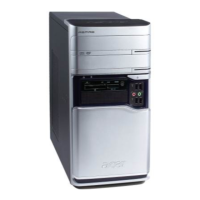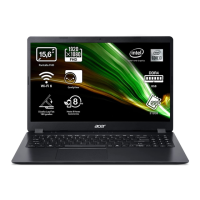
Do you have a question about the Acer Aspire E5-772 and is the answer not in the manual?
| CPU | Intel Core i5 or i7 (depending on model) |
|---|---|
| RAM | Up to 16 GB DDR3L |
| Storage | 256 GB SSD |
| Display | 17.3-inch HD+ (1600 x 900) or Full HD (1920 x 1080) |
| Graphics | NVIDIA GeForce 940M |
Introduces the various guides available for using the computer.
Provides guidance on maintaining and using the computer properly.
Explains the procedures for powering the computer on and off.
Offers advice on how to maintain the computer's condition.
Provides instructions for proper handling and maintenance of the AC adapter.
Details the steps for cleaning and basic servicing of the computer.
Guides on creating system and driver/application backups.
Outlines methods for system recovery, reinstallation, and factory resets.
Details various methods for restoring the system from Windows, hard drive, or backup.
Explains how to connect to the internet using an Ethernet cable.
Describes the computer's built-in capabilities for network connectivity.
Instructions on how to configure the system's boot sequence in BIOS.
Guides on how to set passwords within the BIOS utility.
Explains the purpose and types of passwords for computer security.
Details the process and prompts for entering passwords.
Provides methods to conserve energy and reduce power consumption.
Instructions on how to disable the Fast Startup feature for power saving.
Details about USB 3.0 ports, compatibility, and performance.
Explains the functions and connections of rear audio ports.
Overview of connectivity options including the card reader.
Step-by-step guide on how to insert memory cards into the reader.
Information on different types and capacities of SD cards.
Procedure for safely removing memory cards from the reader.
Details on connecting audio devices like headphones and microphones.
Information on the HDMI interface for digital audio/video connection.
Details on USB standards, port identification, and safe removal.
Addresses common issues like power, audio, keyboard, and printer problems.
Guides on restoring the system and requesting technical support.
How to navigate the Start screen, manage apps, and switch between them.
Personalizing lock screen, tiles, and desktop appearance.
Managing system settings, notifications, accounts, and software updates.
Installing applications and managing Microsoft accounts.
Links to external resources for additional help.
Guide to identifying and resolving common system errors and symptoms.
Guides on connecting to the internet via various methods and wireless setup.
Covers viruses, malware, firewalls, passwords, safe browsing, and updates.
Explains viruses, spyware, malware, and firewalls.
Advice on malware, firewalls, and keeping software updated.
Overview of essential security software like firewalls and antivirus.
Tips for strong passwords and safely sharing personal data online.
Avoiding phishing, fraudulent sites, and protecting email addresses.
Monitoring statements, using Windows security tools, and updates.
Signs that indicate a computer may be compromised by malicious software.











